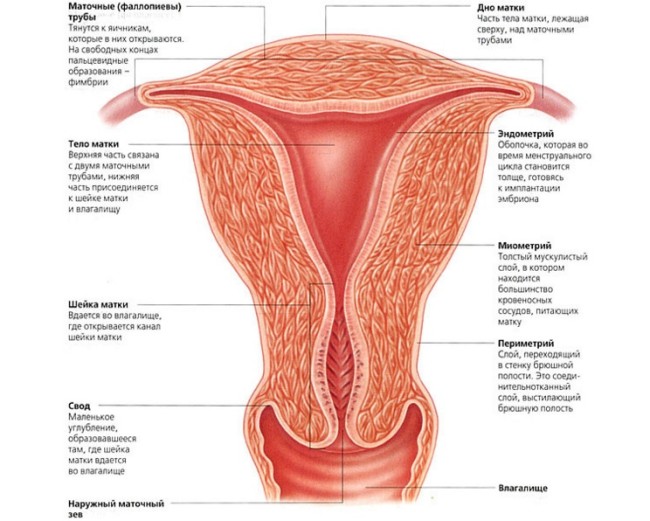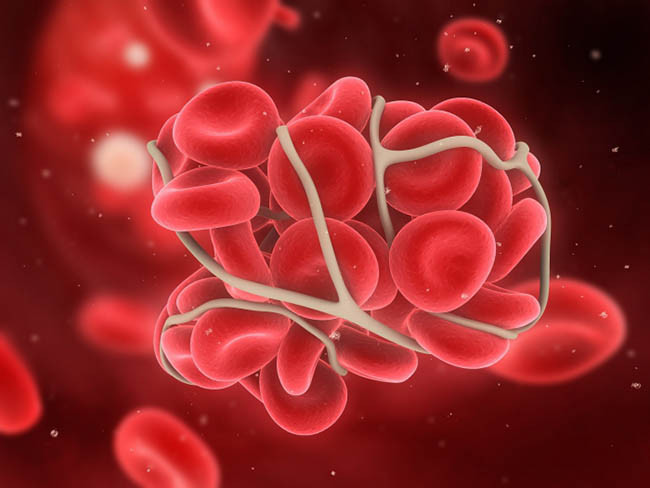Often on critical days, women find discharge in the form of blood clots. Some consider this a variant of the norm, others are concerned about the cause of this phenomenon. It is not worth panicing in such cases-nevertheless, if something has a guard, you should go to the gynecologist. To identify the cause of this phenomenon and exclude the presence of any diseases, in most cases there will be enough simple inspection.
Content
Why do menstruation go with blood clots: the principle of the appearance of clots
With the problem of painful and abundant menstruation, in which there are blood clots, many women occasionally face. If this phenomenon is repeated repeatedly, you should think about the state of health of your reproductive system. Let's try to figure out why the menstruation goes blood clots. To determine what such phenomena are caused, in general terms, the principle of the anatomical structure of the uterus should be understood. In fact, it is a muscle hollow organ in which nature provides for the development of the fetus in case of pregnancy.
This body consists of three layers:
- perimetry - shell covering the uterus;
- myometry - the actual muscle layer;
- endometry - a layer that lines the uterus from the inside.
During the menstrual cycle, you can observe the loosening of the endometrial layer and its thickening - as a result, it is ready to take a fertilized egg. In the case when the pregnancy did not occur, the endometrial layer is rejected and menstrual bleeding is observed (from here you can hear the poetic phrase “The uterus cries with bloody tears”).
In the process of menstruation, a woman loses about a glass (usually up to 200 ml) of blood. Such blood loss is quickly replenished with the female body, so you should not worry. These discharge with a specific smell last several days (usually from 3 to 5), while their color can be modified from scarlet shade to dark cherry or brownish. The consistency of menstrual discharge can also change. Typically, coagulation of such blood is low. Nevertheless, if anticoagulant enzymes do not cope in the process of abundant bleeding, blood, rolled in the form of clots appears among the discharge. With menstruation, clots with a diameter of a few millimeters to 3-4 centimeters can be observed.
The phenomenon, when menstruation goes with clots occasionally, is not considered a pathology. At the same time, for some women, blood clots during menstruation is a familiar phenomenon. Taking a similar problem of a doctor, you can get various explanations of such a problem. As a result of a detailed examination, violations of the work of various systems (in particular, endocrine), or the functioning of individual organs (uterus, as well as ovaries), can be identified. In addition, it is worth considering that excessively abundant menstruation can act as the cause of iron deficiency anemia. If there is a large volume of blood (over 200 ml), it is necessary to consult a gynecologist to find out the causes of this phenomenon. As a norm, doctors mention blood loss with menstruation up to 60 ml per day.
Why do mensher go blood clots: alarming signals
Most often, during menstruation women are concerned about brownish discharge in the form of large clots. If this phenomenon is observed episodically, at the beginning or at the end of the cycle, one should not particularly worry. It is considered an alarming symptom if menstruation goes blood clots throughout the entire period of menstruation. If such discharge is observed for a long time, this phenomenon cannot be launched by itself. Otherwise, it can aggravate additional unpleasant symptoms, as well as the development of various problems in the future - up to infertility and serious disorders of the state of health (in the worst case, oncological diseases). In addition, if menstruation goes clots, iron deficiency anemia can threaten the body due to prolonged abundant bleeding. If there is a feeling of ailment and weakness, reducing performance, dizziness and pallor of the skin, it is worth passing a general blood test. If iron deficiency anemia is detected, the doctor prescribes iron preparations, and after one to two months a significant improvement in well-being can be expected.
If there is an increase in temperature, the appearance of brown blood clots in the discharge and sharp pain in the lower abdomen, you should go to the hospital without delay, since these symptoms may indicate an ectopic pregnancy. A similar situation may pose a threat to life, in this case the immediate help of doctors will be required.
Why do menstruation go with blood clots: the most common causes of their appearance
To maintain female health, it is necessary to carefully monitor the signals of your body. If menstruation is long, while pain appears, as well as discharge that differs from ordinary menstruation, you must pay attention to these symptoms and consult a doctor. The occurrence of an unpleasant odor and a change in the color of the discharge may indicate the development of the inflammatory process.
Thus, every woman needs to track her condition during menstruation. In the case of changes acting as anxiety symptoms, you should consult a doctor. If in menstrual discharge there are a large size of the clocks of dark red or brownish in color, it is necessary to consult with a gynecologist, focusing on this phenomenon. Hormonal malfunctions or inflammatory processes can manifest themselves in a similar way. In addition, menstruation go with blood clots with endometriosis.
Why do mensher go blood clots: endometriosis
A characteristic feature of this disease is the excessive growth (hyperplasia) of endometrial tissues. This is often the menstruation go clots of blood, which are exfolved tissues. Often in cases where menstruation goes blood clots, after a standard gynecological examination, as well as an ultrasound or colposcopy, the gynecologist diagnoses "adenomyosis" (germination of the endometrium into other layers of the uterus). Typical symptoms of this disease are painful, too long periods, accompanied by weakness, pressure drops, sometimes with heat or chills. In addition, with endometriosis, irregular uterine bleeding can be observed.
Hyperplasia of the endometrium can provoke various causes that provoke changes in the hormonal background - observed, for example, with diabetes. In addition, some doctors argue that endometriosis can develop due to changes that are not dependent on external circumstances at the genetic level. It should be noted that an advanced disease of endometrial hyperplasia increases the risk of infertility.
Why do meion -offs go blood clots: congenital uterineal abnormalities
Some women have an irregular shape of the uterus or the presence of partitions inside its cavity. This structure refers to congenital or acquired (due to an incorrect lifestyle, abuse of bad habits) abnormalities. Hereditary diseases, professional harmful effects, smoking abuse can act as such violations. A similar structure of the uterus can act as causes that prevent the outflow of blood. As a result, it stagnates in the uterine cavity, while the periods go with blood clots. Anomalies in the development of this organ are often accompanied by violations of the hormonal background, as well as painful menstruation. If the structure that differs from the norm is detected, surgical treatment can be applied after a thorough examination in some cases.
Why do menstruation go blood clots: hormonal disorders
Often, as the reasons for the appearance of abundant menstruation, accompanied by the appearance of clots, various hormonal disorders of the functioning of various body systems, including the cerebral cortex, hypothalamus and pituitary gland, as well as the pelvic organs in the form of uterus and ovary. In addition, hormonal malfunctions can be triggered by thyroid diseases, as well as adrenal glands. To identify such phenomena, you will need to undergo a complete examination. If there are suspicions regarding the presence of malnutrition of the pituitary gland and hypothalamus, magnetic resonance or computed tomography will be required. In case of detection of tumors, they are removed, other violations are treated with conservative methods.
Various diseases of the hypothalamus, including tumor, can provoke increased production of the follicletropin pituitary gland (follicle -stimulating hormone). Due to such increased secretion, an acceleration of the maturation of the egg and the suppression of the luteinizing, as well as the female hormone progesterone, is observed, while the production of estrogen increases. As a result, the growth of the endometrial layer is observed - and, as a result of rejection of this mucous membrane, bleeding is observed (monthly with blood clots go abundantly). Under the influence of estrogens, the reverse development of the temporal gland of internal secretion (yellow body of the ovary) can occur - while the production of progesterone is reduced, as a result, abundant menstrual discharge is observed, often with blood clots.
Why do mensher go blood clots: other reasons
In addition, there are other causes of blood clots:
- diseases of various organs of the pelvis (infectious and inflammatory) can affect the uterus, as well as ovaries and phallopian pipes, provoking heavy discharge with clots and pain;
- cases when discharge with clots is observed within a month after childbirth are considered the norm. At the same time, it is necessary to take into account the following - if this phenomenon is combined with an increase in temperature, this may indicate the placenta tissues remaining in the uterus. In such cases, it is necessary to postpone the doctor without postponing. If the uterus is poorly reduced, the doctor will prescribe special drugs that contribute to the normalization of its condition. If the remains of the placenta are detected, the curettage may be needed;
- after the recently carried out abortion on the uterine mucosa, notches may remain, in which blood coagulation with the subsequent output is observed;
- if a woman leads a sex life, in the presence of bloody-eating bloody yellow, with the presence of clots, it is necessary to consult a gynecologist-perhaps this symptom indicates the rejection of the fetal egg, i.e. interruption for any reason for pregnancy;
- in the case of neoplasms on the walls and neck of the uterus in the form of polyps, cysts or fibroids can also be observed monthly with clots. In rare cases, the atypical course of menstruation may indicate the development of cancer;
- in the presence of an intrauterine spiral, abundant menstruation is often observed, while clots often appear (in this way the remains of a fertilized egg are removed with blood);
- as the reason why the menstruation goes blood clots is occasionally taking an excessive amount of vitamins of group B;
- the appearance of clots can be observed in the case of individual diseases that provoke an increase in blood coagulation, as well as after taking some drugs;
- in addition, the reasons for why menstruation go with blood clots can act as stressful situations, as well as bad habits in the form of immoderate alcohol and smoking.
Thus, if menstruation goes blood clots, you should not immediately panic. Nevertheless, you should also not be frivolous about your health. In the case of the appearance of previously abundant menstruation with clots, you do not need to wait for everything to go by itself. In the presence of disturbing symptoms, you should visit a gynecologist in order to get useful recommendations - as well as if necessary, undergo a course of treatment.















Comments
a couple of years ago, there was no side of metrogils from the same problem, there were no side effects ...
I’m not a fan of peeling at all, it saves from acne of metrogil, it also smoothes it ...
Great article! ...
I take the second course of the Capsules Climafite 911. The tides went very quickly. It became calmer, irritability went away and I sleep well ...
i also noticed - it is worth nervous, everything immediately affects the face. Therefore, I try to avoid conflicts and unpleasant people. Of the creams, I like Miaflow from wrinkles - smoothes not only small wrinkles ...